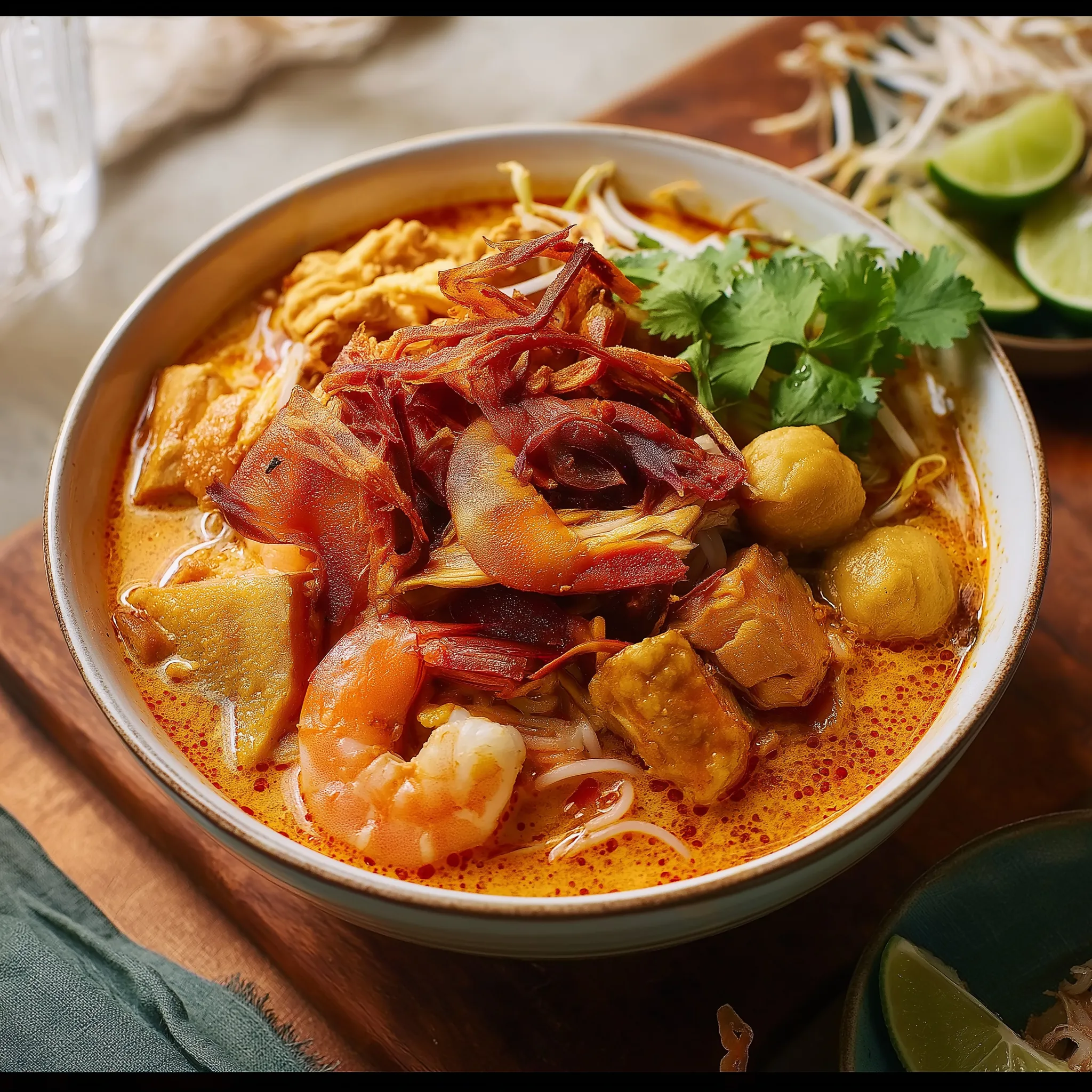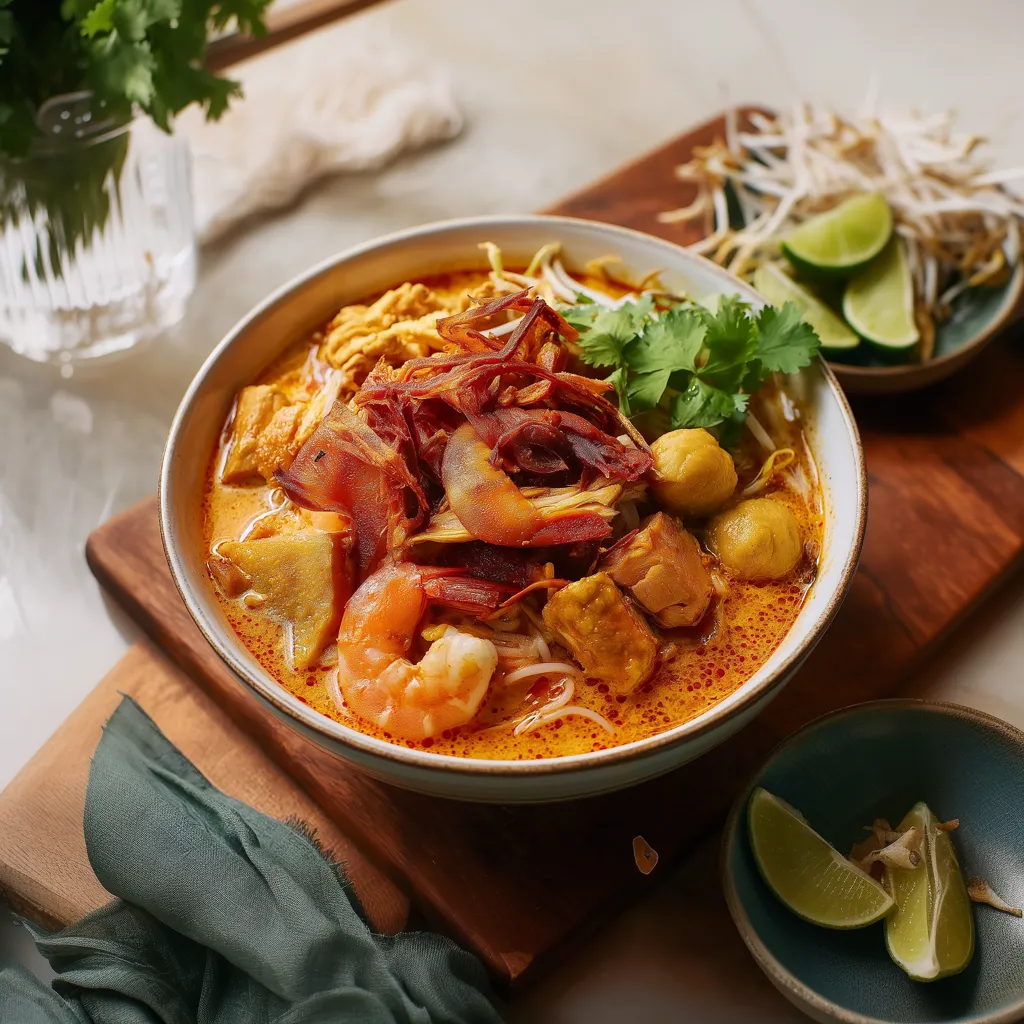 Save
Save
This hearty Malaysian Laksa noodle soup has become my weekend comfort food ritual, bringing authentic Southeast Asian flavors right to my dining table without requiring a culinary degree.
I first discovered Laksa during a rainy vacation in Singapore where it was served at a tiny stall with a line around the block. After countless attempts to recreate that magical first taste, this recipe finally captured the essence of what made me fall in love with this dish.
Ingredients
- Bone-in chicken thighs provide a deeper flavor than boneless cuts and the rendered fat enriches the broth beautifully
- Laksa paste forms the foundation of authentic flavor look for Mae Ploy or Maesri brands for the most traditional taste profile
- Fresh lemongrass adds irreplaceable citrusy aroma that dried simply cannot match
- Thai chilies adjust quantity based on your heat preference one gives gentle warmth while three delivers significant fire
- Coconut milk use full-fat for the richest mouthfeel and authentic creaminess
- Soy puffs these spongy delights absorb the broth making them flavor bombs in every bite
- Fresh lime juice brightens the entire dish and cuts through the richness
- Shallots when fried create the essential textural contrast against the soft noodles and broth
Step-by-Step Instructions
- Roast the Chicken
- Preheat oven to 400°F and season chicken thighs generously with salt and white pepper. Roast for 40 minutes until skin turns golden and crispy. The slow roasting develops deep flavor compounds that will enrich your broth later.
- Create the Flavor Base
- Heat oil in a large pot over medium heat and add minced garlic and ginger. Cook for exactly one minute until fragrant but not browned. Add lemongrass and chilies next cooking for three minutes to soften and release their essential oils into the fat.
- Build the Broth
- Add laksa paste and brown sugar frying for three minutes to caramelize slightly and intensify the flavors. Pour in chicken stock and coconut milk stirring continuously to incorporate. Add fish sauce and bring to a gentle boil before reducing to a simmer.
- Prepare the Noodles
- Rinse your chosen noodles according to package directions. For rice vermicelli simply soak in warm water until pliable about 2 minutes. For egg noodles a quick 1 minute boil is sufficient. Divide among serving bowls immediately to prevent sticking.
- Assemble the Protein Elements
- Shred the roasted chicken including the crispy skin for added texture and flavor. Pour any pan drippings directly into your simmering broth for maximum flavor. Quickly sear seasoned shrimp just until they turn pink about 90 seconds per side.
- Final Flavor Adjustments
- Season broth with fresh lime juice and additional fish sauce to taste. The perfect balance should have noticeable saltiness balanced by tanginess with coconut richness in the background. If too spicy add a touch more sugar to balance.
- Create the Garnishes
- Toss thinly sliced shallots in flour and fry until golden brown and crispy about 2 minutes. Drain on paper towels and sprinkle lightly with salt while still hot. Prepare bean sprouts and cilantro leaves keeping them separate until the final assembly.
 Save
Save
My absolute favorite ingredient in this recipe is the humble soy puff. These unassuming little sponges soak up the broth like nothing else and burst with flavor when you bite into them. My Malaysian friend laughed when I admitted I sometimes make Laksa just as an excuse to eat these broth-soaked treasures.
Make Ahead Magic
Laksa broth can be prepared up to three days in advance and stored in the refrigerator. This not only saves time on busy days but actually improves the flavor as the spices have more time to meld together. When ready to serve simply reheat the broth until steaming then continue with freshly prepared noodles and toppings for the best texture contrast.
Regional Variations
Laksa appears across Southeast Asia with fascinating regional differences. Penang Laksa uses fish and tamarind for a sour profile while Singapore Laksa like this recipe leans on coconut milk for richness. In Malaysia you might find Laksa Johor served with spaghetti instead of rice noodles a colonial influence that has become tradition. Feel free to research these variations and adjust this recipe to explore different regional styles.
Perfect Pairings
Serve your Laksa with a side of sambal for those who desire extra heat or a small saucer of lime wedges for additional brightness. For a complete Southeast Asian experience pair with spring rolls or satay skewers as appetizers. Beverage wise nothing cuts through the richness better than an ice cold Tiger beer or for non alcoholic options a glass of sweetened iced tea with lime provides refreshing contrast.
Troubleshooting Tips
If your broth separates which can happen with coconut milk simply whisk vigorously when reheating. Should your laksa taste flat add more fish sauce rather than salt for authentic depth. For veggie lovers this recipe adapts beautifully by substituting vegetable stock and adding pan fried tofu and more vegetables like bok choy or mushrooms in place of the animal proteins.
 Save
Save
Recipe Q&A
- → Can I use store-bought laksa paste?
Yes, store-bought laksa paste works perfectly in this recipe. Look for it in Asian grocery stores or international food sections. If you can't find it, red curry paste makes a reasonable substitute, though the flavor profile will be slightly different.
- → What are soy puffs and can I substitute them?
Soy puffs (also called tofu puffs) are deep-fried tofu cubes with a spongy texture that absorbs broth wonderfully. You can find them in Asian markets, but if unavailable, you can substitute with firm tofu cubes or simply omit them.
- → Which type of noodles work best for laksa?
Traditional laksa can use various noodles including Hokkien egg noodles, rice vermicelli, or wheat noodles. For authentic texture, use a combination of both egg and rice noodles. Choose based on personal preference - thicker noodles offer more chew while rice vermicelli is lighter.
- → How spicy is this laksa and can I adjust the heat level?
This laksa has moderate heat from Thai chilies and the laksa paste. To reduce spiciness, use fewer chilies or remove the seeds. For extra heat, add more chilies or a dollop of sambal oelek. The coconut milk helps balance the spice.
- → Can I make laksa in advance?
The broth actually improves with time as flavors meld. You can prepare it 1-2 days ahead and refrigerate. Store components separately: broth, cooked noodles, chicken, and toppings. Reheat the broth thoroughly before assembling bowls with fresh toppings.
- → What can I substitute for fish sauce?
If avoiding fish sauce, use soy sauce with a squeeze of lime juice to approximate the salty-umami flavor profile. Vegetarians can use mushroom sauce or liquid aminos. Adjust quantities to taste, as these alternatives have different salt concentrations.
